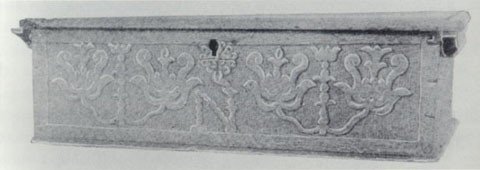

Chest with drawers, Wethersfield, Connecticut, 1675-1700. Oak with pine. H. 40", W. 48", D. 20". (Courtesy, Historic Deerfield, Inc.; photo, Amanda Merullo.) In The Furniture of Historic Deerfield (New York: E. P. Dutton & Co., 1976), p. 167, Dean A. Fales Jr. speculated that the chest may have descended from Hannah Talcott (1665-1741), who married Major John Chester at Wethersfield in 1686, to their daughter Sarah. historic-deerfield.org

Chest with drawers, Wethersfield, Connecticut, 1704. Oak with pine. H. 37 1/4", W. 48", D. 21" . (Courtesy, © The Art Institute of Chicago, Wirt D. Walker Fund, acc.1993.521)

Chest, Wethersfield, Connecticut, 1670-1690. Red oak with yellow pine. H. 26", W. 48 1/2", D. 20 1/4". (Courtesy, Webb-Deane-Stevens Museum; photo, Gavin Ashworth.)
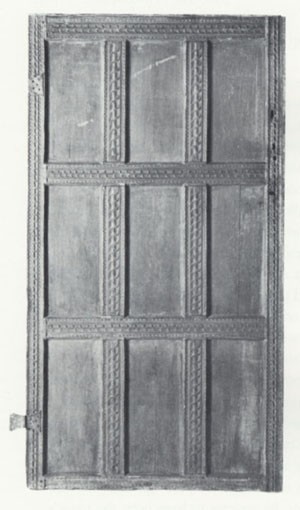
Door, Wethersfield, Connecticut, 1640-1680. Yellow pine. H. 70 3/8", W. 38 1/4", D. 1 1/4". (Courtesy, The Connecticut Historical Society, Hartford, Connecticut.)
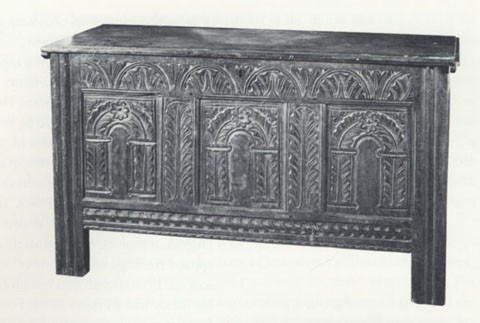
Chest, probably Windsor, Connecticut, 1640-1680. White oak and white pine (top) with tulip poplar. H. 27", W. 48", D. 19 3/4". (Courtesy, Yale University Art Gallery, The Mabel Brady Garvan Collection.)
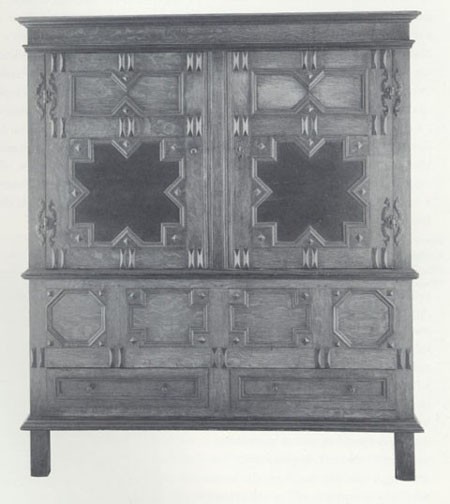
Press, Wethersfield, Connecticut, 1670-1690. Oak with yellow pine. H. 67", W. 68", D. 19". (Courtesy, Hartford Steam Boiler Inspection and Insurance Company; photo, Gavin Ashworth.)

Chest with drawers, Wethersfield, Connecticut, 1675-1690. Oak with pine. H. 37
3/4", W. 45 7/8", D. 19 3/8". (Courtesy, The Connecticut Historical Society, Hartford, Connecticut.)
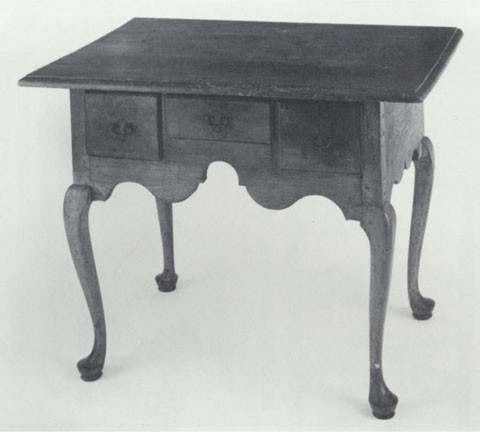
Dressing table attributed to Return Belden, Wethersfield, Connecticut, 1740-1760. Sycamore with white and yellow pine. H. 27 3/8", W. 35", D. 24 1/2". (Courtesy, Porter Phelps Huntington Historic House Museum; photo, Gavin Ashworth.)
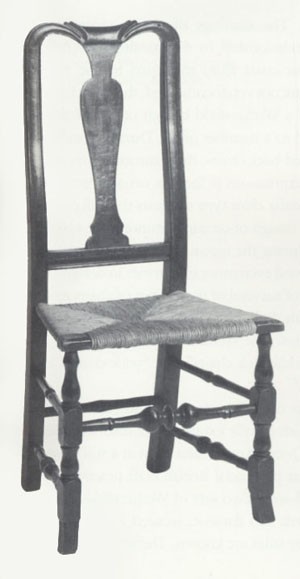
Side chair, Wethersfield, Connecticut, 1740-1770. Maple; remnants of original black paint. H. 40", W. 19 3/4", D. 14". (Courtesy, Brooklyn Museum, Dick S. Ramsay Fund.) This chair is from a set of at least five originally owned by Dr. Ezekiel Porter (1706-1775) of Wethersfield. A very similar set descended in the Buck family of Wethersfield.

Armchair, Wethersfield, Connecticut, 1735-1790. Poplar and ash. H. 44 3/8", W. 15 1/2" (seat), D. 14 5/8". (Courtesy, Yale University Art Gallery, The Mabel Brady Garvan Collection.) Four side chairs and an armchair of this type are owned in Wethersfield by a descendant of the original owner.
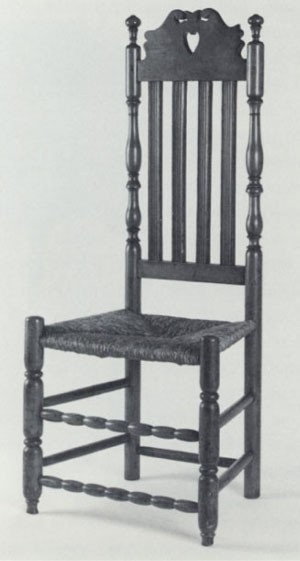
Side chair, probably Norwalk, Connecticut, 1750-1760. Maple and ash. H. 43 3/4", W. 19", D. 15." (Courtesy, Webb-Deane-Stevens Museum; photo, Gavin Ashworth.)
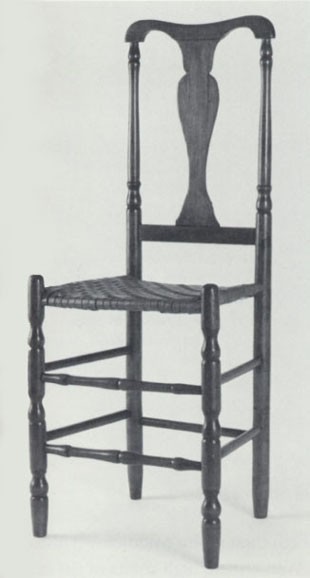
Side chair, Wethersfield, Connecticut, 1770-1790. Hickory and pine. H. 45", W. 17", D. 13". (Courtesy, Webb-Deane-Stevens Museum; photo, Gavin Ashworth.)
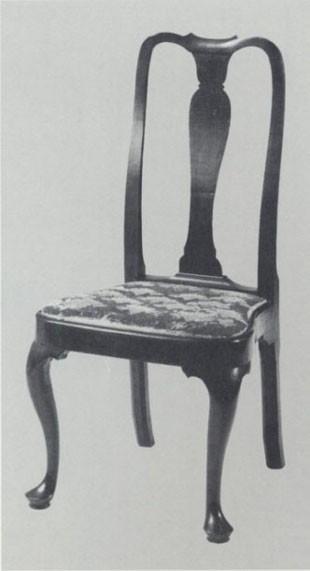
Side chair, Wethersfield, Connecticut, 1750-1770. Cherry and maple. H. 41", W. 15 1/4", D. 17 1/2". (Courtesy, Brooklyn Museum, Henry L. Batterman Fund.) This is one of a set of chairs possibly owned by Dr. Ezekiel Porter of Wethersfield (see also fig. 10) and probably owned by his son-in-law, Colonel Thomas Belden (1732-1782).
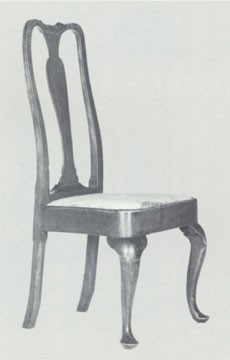
Side chair, Wethersfield, Connecticut, 1735-1760. Cherry. H. 40 1/2", W. 18 1/2", D. 15 1/4". (Private collection; photo courtesy, Connecticut Historical Society.) This chair is from a set of at least five. The slip seats of two chairs have most of their original foundation upholstery and remnants of their needlework covers.
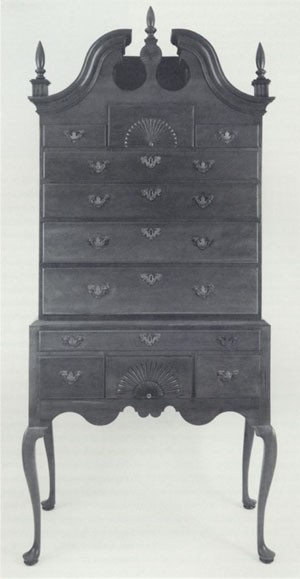
High chest of drawers, possibly Middletown, Connecticut, 1760-1780. Cherry with pine and tulip poplar. H. 86", W. 29 1/2", D. 21". (Courtesy, Middlesex County Historical Society; photo, Gavin Ashworth.)
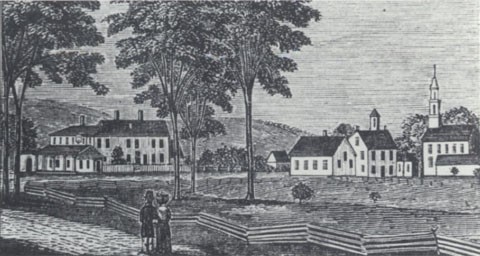
Southwest View of Bernardston, Massachusetts, ca. 1838. (From John W. Barber, Massachusetts Historical Collections [Worcester, Mass.: Dorr, Howland, 1839].)
This essay consists of three reflections on the material culture of a particular region: the Connecticut River Valley of Connecticut and neighboring western Massachusetts. It examines seventeenth-century Wethersfield, Connecticut, case furniture; explores the origins of some classic expressions of eighteenth-century furniture; and concludes with a once commonplace type of artifact, the worm fence. An analysis of these selected items as texts illuminates the problematic relationship between the study of material culture and the study of a region. In particular these objects challenge the uncritical use of such terms as "traditional" and "folk," which are usually embedded in studies of regional material culture.
Despite the pitfalls, an approach to a region's culture that is sensitive to problems inherent in the concept of regionalism and in the historical study of material culture can be used to raise questions about cultural innovation as well as the persistence of cultural patterns. In New England, a regional approach, particularly one using material culture, provides a way out of the parochial embrace of studies focusing on a single town and its community. Translocal communities become much more obvious when defined by craft and class and when the field of vision is expanded to include more geography and more evidence, especially of the material sort.
To realize the potential of this approach one has to disentangle the regional study of material culture from the study of regionalism. Ideologically, the study of regionalism in America owes much to the concerns of the 1930s. In almost all of its various manifestations, be they literary, artistic, or scholarly, the concept of regionalism expressed a search for the essence of America and a yearning for community stability amidst the disruptions and discouragements of the Depression. In the words of one scholar, America's regions appeared to embody "a communal form of living that existed apart from the formal institutions and the pressures of industrial capitalism."[1]
For some scholars, the study of regionalism became a self-conscious search for a simpler, more spiritual culture that could be contrasted to the complex and materialistic world of twentieth-century industrial capitalism. The prominent sociologist and theorist of regionalism, Howard W. Odum, treated regions as "an extension and an attribute to the 'folk,'" and, therefore, regions served as "living, physical area tabernacles for the folk cultures of the world to maintain a quality culture in a quantity world." Because regional cultures were basically folk cultures, Odum saw them as "natural," "isolated," and "relatively homogeneous." Other sociologists similarly defined regions as "comprised of a constellation of communities" characterized by "a homogeneity of economic and social structure," "whose people are bound together by mutual dependencies arising from common interests."[2]
The original emphasis on presumed isolation, homogeneity, shared values, and community has continued to influence the study of regions by students of folklife, anthropologists, historians, and others who often do not share the ideological agendas of the first students of regionalism. Even recent studies of traditional or folk material culture and regionalism often embrace a vision of homogeneous communities that are relatively or completely isolated from outside influences and in which change occurs very slowly, if at all. In New England, this vision is reinforced by the persistent belief in the initial establishment by the Puritan settlers of prelapsarian communities—whether John Winthrop's "city upon a hill" or the modern social historian's "Christian Utopian closed corporate community."[3]
Such a view of culture and region makes explanations of cultural change particularly problematic. Explanations of changes in material culture can end up contributing to the long-established tradition of viewing New England's colonial history as a story of declension. Alternatively, cultural change is explained by cataclysms or semantic sleights of hand that a growing number of historians find unconvincing. As historian Joyce Appleby observed, "The normative quality given continuity and persistence then leads to an interpretation of change as the promoter of tensions, fear, anxiety, and guilt."[4]
For a number of students of early American material culture, the third quarter of the eighteenth century is a period of dramatic cultural change. These scholars see a profound change in the character of artifacts as well as a change in the quantity of artifacts. The changes are seen as reflecting and encouraging the acceptance of a "Georgian world view." Archaeologist James Deetz finds this new world view to be "mechanical where the older was organic, balanced where the older had been asymmetrical, individualized where the older had been corporate."[5] The acceptance of this Georgian world view marked the replacement of a traditional, homogeneous, folk culture by an individualistic, popular culture. This Anglicized or "re-Anglicized" popular culture also supplanted the regional variations that distinguished folk material culture in seventeenth- and early-eighteenth-century New England.
Although evidence drawn from the Connecticut Valley could be used to interpret changes during this period as such a reordering of the region's material and intellectual universe, to do so misinterprets the material culture of the seventeenth and early eighteenth centuries. The region's material culture in 1750 or 1680 cannot be characterized as "traditional" or "folk" if these terms are meant to suggest a slowly changing material culture shaped in isolation by a relatively homogeneous society and undiversified economy.[6] Marked from the outset by hierarchical distinctions in form, gravestone motifs and furniture styles went through three or four changes between 1635 and 1760. Housing also varied by class and went through more subtle changes during the same period of time. From the earliest period, artifacts produced and used in the region were shaped by three distinguishable but interrelated social groups: the craft dynasties, the gentry elite, and the yeomen farmers. Throughout the seventeenth and eighteenth centuries, commercial agriculture, mercantile activity, and specialized preindustrial production shaped and constantly modified the region's material culture. Most artifacts produced and consumed in this context were products of an Anglicized popular culture, though in important ways distinctive variants of it.[7]
The period from 1635 to 1670 witnessed the transplanting of English culture in its various localized embodiments to the Connecticut River Valley. The character of this process, which occurred throughout New England, is described in a number of studies by David Grayson Allen, James Deetz, Robert Blair St. George, Robert Trent, and others.[8] The usual emphasis in these studies is on the direct transference of English artifactual prototypes to relatively homogeneous and, for some, rather "traditional" communities.
The picture that emerges from a study of the social landscape and material culture of the Connecticut Valley during the seventeenth century is a bit different. The physical survivals and documentary evidence create a picture of diverse communities that often quarreled over matters of religion and supported several distinct shop traditions of woodworkers. These patterns of behavior are not necessarily related, but the diversity suggested by both types of evidence fits poorly with pictures of homogeneous, corporate communities so popular in the historical studies of New England towns produced during the 1970s. Because of the focus on relatively homogeneous and atypical communities such as Hartford and Windsor, diversity, turbulence, and the special character of the early history of the Connecticut Valley often get overlooked.[9]
The 1634 settlement at Wethersfield, which makes claim to be the first English town settled in the Connecticut Valley, can perhaps make a better case for typicality. Wethersfield was not settled by a united church of Puritans shepherded out of Massachusetts by a charismatic pastor. John Oldham, a trader, and John Chester, a minor English gentleman, led the original ten adventurers who came to Wethersfield from Watertown, Massachusetts. The members of the initial group and subsequent settlers came from a variety of English backgrounds, and the origins of the town's first woodworkers reflected this diversity. Surviving objects and the backgrounds of carpenters, joiners, turners and shipwrights document the presence of joinery traditions originating in East Anglia, the north of England, and the West Country, and of building practices from East Anglia, the Hampshire-Wiltshire region, and possibly London.[10]
The shops were typically family organized and perpetuated by master-apprentice relationships that passed from a father to a son or a son-in-law or a nephew. The family rather than the town determined the cultural horizons inßuencing individual craftsmen. The development of family networks, which even in the mid-1600s transcended town boundaries, determined the diffusion and persistence of particular craft practices that influenced the construction and appearance of furniture and houses. The marriage of joiner Samuel Steele to joiner James Boosey's daughter linked Wethersfield and Farmington woodworkers before 1650; members of the Gilbert family of carpenters, joiners, and glazers lived and worked in Windsor, Wethersfield, Hartford, Springfield, Northampton, and possibly New Haven; and joiners from the Dickinson family moved up the Connecticut River into western Massachusetts and back to Wethersfield by the late 1670s.[11]
Disparate English shop traditions persisted in seventeenth-century Wethersfield. There was no such thing as a Wethersfield style or a Connecticut Valley style at the time. Surviving furniture and documentary sources provide evidence for the existence in Wethersfield of five or six different joinery shops. By the late seventeenth century, locally produced furniture often revealed the influence of more than one English tradition as woodworkers responded to new influences. Local transformations as well as literal transplanting of English shop traditions shaped the character of Wethersfield furniture.
An oak box decorated with carved flowers and the letter "N" probably represents the work of first-generation joiner John Nott (d. 1682). The box, which descended in the Nott family, is known from an illustration in Luke Vincent Lockwood's Colonial Furniture in America (fig. 1).[12] The profiles of the tulips bear an obvious relationship to those in secondary locations on "sunflower" chests from the Wethersfield area. Especially striking is the similarity between the box's two smaller tulips and the tulip found on the muntin of the lower drawer of a joined chest that reportedly descended in the John Chester family of Wethersfield (fig. 2), as well as the similarity between the box's four larger tulips and the smaller tulips on the flanking panels of the facade of a carved and painted chest dated 1704 (fig. 3). The carving on the Nott box is also set off by a background stippled in a manner similar to that on many "sunflower" chests.
The box's decoration and John Nott's origins in the north of England suggest that he may have been the source for the tulips, roses, and vines that became prominent features of the "sunflower" and Hadley chests made during the late seventeenth and early eighteenth centuries. Several scholars have suggested that the origins of both Connecticut Valley carving traditions lay in the north of England, and Nott was well situated to influence woodworkers who produced both types of chests. From his arrival in the late 1630s to his "retirement" about 1675, he appears to have been the town's most prominent woodworker and his joinery shop next to the meetinghouse was a Wethersfield landmark.[13]
Totally unrelated to this box is a joined chest, with low relief carving, owned in Glastonbury, which was a part of Wethersfield until 1693 (fig. 4). It may represent a tradition from the west of England, where joiners frequently used similar combinations of motifs. The finished, four-panel back of the chest, which is closer to English joinery practices than the single framed panel commonly found on "sunflower" chests, suggests that the chest is the work of a first-generation joiner. It is, however, a late exam- ple of first-generation work, for it has millsawn bottom boards, dating the chest no earlier than the late 1660s when the first sawmills began operation in Wethersfield.[14]
Another early shop having possible West Country origins may have produced a nine-panel joined door from a house in Rocky Hill, which was Wethersfield's Stepney parish until 1843 (fig. 5). The door documents the richness and the diversity of joinery work found in early Wethersfield and suggests that some early woodworking traditions had a regional, as opposed to a purely local, pattern of diffusion. The muntins of this door are ornamented with rope moldings that strongly resemble the decoration on the lower rail of a joined chest with a recovery history in Windsor, Connecticut (fig. 6). Despite its location, this chest (and a related chest with a Windsor history at Memorial Hall in Deerfield, Massachusetts) have been linked to a group of New Haven chests. The group, which exhibits elements associated with furniture from the West Country of England, is believed to be the work of first-generation joiners active between 1640 and 1680.[15]
A press that descended in the Goodrich family of Wethersfield provides even more dramatic evidence of the presence of outside influences and the arrival of new designs there during the late seventeenth century (fig. 7). Although the Nott box, the Glastonbury chest, and the Rocky Hill door are late expressions of a carved mode of Mannerism (introduced into England in the 1520s), the Goodrich press has applied ornament, which is characteristic of a later phase of that style (introduced into England in the later 1500s and early 1600s). On seventeenth-century New England furniture, the use of geometrically patterned moldings, prisms, and glyphs usually suggests the presence of London-trained artisans or New England artisans trained or influenced by London woodworkers.[16] A member of the Goodrich family may have inherited the press or purchased it from a joiner working in another town or city. If locally made, the press probably represents the work of an outsider, since its ornament and construction differ from the three shop traditions described above.
The most likely source of the applied-ornamental style in Wethersfield is Peter Blin (ca. 1640-1725), a joiner credited with the production of many Wethersfield "sunflower" chests. The circumstantial evidence for this association is strong. Blin arrived in Wethersfield around 1675, just before the Reverend Joseph Rowlandson (d. 1678) acquired a "sunflower" cupboard with turned and applied ornament and about the time John Nott "retired." In addition, most of Blin's contemporaries were locally trained, or they arrived in Wethersfield after 1678. Traditionally, scholars credited Blin with the introduction of motifs drawn from either the north of England or Huguenot sources, but they barely considered the geometric moldings and applied turnings on "sunflower" chests, both of which suggest London sources. Even though Blin was probably Francophone, it is more likely that his family had its roots in the French-speaking communities of the Low Countries or the Channel Islands. Blin family tradition also maintains that he came to New England from London instead of from the north of England; therefore, John Nott is a more plausible bearer and disseminator of a North Country carving tradition.[17]
The late Mannerist applied style, exemplified by the ornament on the Goodrich press, did not totally supplant the earlier carved style. The largest group of late-seventeenth-century Wethersfield furniture—the forty to eighty chests and seven cupboards with "sunflower" motifs—has carved Tudor roses, tulips, and thistles and (with two exceptions) applied spindles and bosses (fig. 8). Production of these case pieces required joinery and turning skills, and although Peter Blin apparently was proficient in both trades, other evidence suggests that more than one tradesman produced these chests and cupboards. Variations in the motifs and execution of the carved panels and minor variations in the drawer construction of some chests indicate the work of different hands. During the late seventeenth century, Wethersfield also supported at least two other turners, Joseph Andrus (or Andrews) (1651-1706) and Nathaniel Foote (1647-1703), the latter of whom had business dealings with Blin.[18] Part of this group of case pieces may represent the work of Foote and Obediah Dickinson (1641-1698), a joiner who probably trained in Wethersfield, left town, then returned about 1680.[19] The size of the "sunflower" group and the existence of chests with strong histories of ownership outside Wethersfield suggests production from different shops as well as individual shops employing several workmen.
Regardless of their makers' identity, the "sunflower" chests and cupboards reveal the complex character of late-seventeenth-century furniture, which makes the use of the term traditional or "folk" problematic. The chests and cupboards in this group combine high-style motifs based on the manipulation of classical forms with older vernacular motifs such as flowers and hearts. Carved motifs such as Tudor roses and Scottish thistles reflect the influence of the larger political community of which Wethersfield was a distant part. The presence of tulips and vines, based in part on North Country motifs probably dating to the previous century, with more up-to-date spindles and moldings painted to suggest exotics—ebony and possibly snake wood—indicates that both innovation and the preservation of tradition were conscious choices made in the presence of alternatives (see fig. 8). Even though its material composition seems to suggest an insular community, the furniture's ornamentation documents on-going contact with the outside, and, therefore, instead of embodying a long-established and geographically restricted "tradition," this kind of chest gave expression to a "horizon," a "pattern characterized by widespread distribution of a complex of cultural traits that lasts a relatively short time."[20]
Innovation generally occurs first in decoration, whereas form is usually the place where tradition is manifested and retained. With the "sunflower" chests, both form and decoration are modified and adapted from various sources. The basic chest form, with its undivided storage space and lift-top, dates to the Middle Ages, possibly to Antiquity. The addition of one or two drawers to the vast majority of the Wethersfield "sunflower" chests resulted from the appearance locally in the 1670s of the chest of drawers, a form first produced in the 1630s for members of the English urban middle class. The addition of drawers to the traditional chest form thus bespoke urban influences, a practical need to store and differentiate a growing quantity of smaller items, and a willingness to spend more to obtain a more expensive form. The relative cost of a "sunflower" chest compared to a six-board chest that provided an equivalent amount of storage space indicates a growing level of prosperity and a rising standard of living. The numbers in which the chests survive from a community that had only sixty to eighty households during the late seventeenth century suggests that they were widely distributed in Wethersfield.[21]
Despite the evidence of some innovation within the dominant shop tradition, most furniture made and owned in Wethersfield during the late 1600s and early 1700s adhered closely to late-seventeenth-century forms and styles. Joined chests with and without drawers and board chests were the most common types of case furniture, and older types of seating, such as stools and forms, remained in use. The number of chairs in local households increased, and during the early 1700s, a few residents owned cane chairs and leather chairs, possibly imported from Boston. All of the locally made case furniture from this period is joined rather than being dovetailed. Joiners, carpenters, and turners who were born and trained in Wethersfield made the bulk of the furniture used in the town. Though susceptible to outside influences, the Wethersfield woodworkers active between 1680 and 1730 were essentially an in-grown, if not inward-looking, group.[22]
The situation began to change as the population and prosperity of Wethersfield increased during the next fifty years. The town's population grew from less than 2000 in 1730 to almost 3500 by 1774. Shipping tonnage owned by residents increased dramatically between 1730 and 1780. In the 1770s, six merchants traded directly with the West Indies, and five to six ships sailed from the town. By the eve of the American Revolution, Wethersfield had become an urban village, the second most densely populated town in the colony. The principal beneficiaries of this increased commercial activity and population growth appear to have been those who worked in the town's expanding service sector. One-fourth to one-third of the male taxpayers in Wethersfield proper (the town's First Society) derived a part of their income from nonagricultural sources such as commercial, professional, and craft activity, and by the 1770s, the town ranked among the top quarter of Connecticut towns as measured by artisan activity.[23] The presence of a relatively large number of craftsmen provided opportunities for cooperation and inspired the competition that produced more innovative and often more cosmopolitan cultural expressions.
During the mid-1700s, woodworkers moved to Wethersfield to set up shop as chairmakers, joiners, and shipwrights. The arrival of woodworkers, especially those from eastern Massachusetts, inßuenced the character of furniture, of buildings, and possibly, though the evidence does not survive, of ships. The traits commonly associated with high-style, eighteenth-century Connecticut Valley furniture and house joinery were not indigenous products that spontaneously generated in the rich alluvial soil of the river's bottomlands. They resulted from a combination of an economically attractive environment for migrating craftsmen bearing new designs and the patronage of merchants, professionals, and yeomen with pretensions and some means, but not unlimited means. The resulting combination of inßuences created cosmopolitan yet restrained provincial expressions.
The first group of newcomers migrated from eastern Massachusetts. Early in the 1720s, Hezekiah May (1696-1783) of Roxbury, Massachusetts, arrived in town, apparently to do the joinery work on the Newington Parish meetinghouse. He stayed and eventually became one of the town's leading house joiners and builders. His reputation ran from Saybrook at the mouth of the Connecticut River to Hatfield in western Massachusetts. Hezekiah's son Samuel (1724-1792) and his grandson William (1749-1809) followed the same trade. Charlestown, Massachusetts, cabinetmaker William Manley arrived around 1730, maintained a shop for fifteen years, and trained apprentices such as Return Belden (1721-1764). Thomas Brigden (1703-1781), a contemporary of Manley's from Charlestown, established a chairmaker's shop in the early 1740s that continued into the early 1800s.[24]
Eastern Massachusetts design and construction techniques had a profound inßuence on Wethersfield and, more broadly, on Connecticut Valley furniture and homes. The deeply scalloped skirts of high chests made in Wethersfield between 1740 and 1760 and the use of central draw runners and double-beaded drawer sides document the indebtedness of Wethersfield furniture makers to Boston designs and construction practices (fig. 9). Surviving examples of locally owned and made crooked-back chairs also reveal the inßuence of designs from eastern Massachusetts (fig. 10). Architectural historian Abbott Cummings characterized Wethersfield's Buttolph-Williams house (ca. 1721) as displaying "one of the most extensive arrays of features associated with Massachusetts Bay".[25] The scalloped cupboard and the twist-turn newel post in the Joseph Webb house (ca. 1752) relate directly to interior joinery work in Boston's Thomas Hancock house (ca. 1737) and its contemporary neighbors.
Influences came to Wethersfield from areas other than eastern Massachusetts. Chairs and case furniture made between 1730 and 1780 suggest the presence of chairmakers and cabinetmakers with ties to coastal and southeastern Connecticut. For example, the Atwood family and Thomas Brigden made crown chairs—a distinctive seating form more commonly associated with coastal Connecticut—and references to this chair type appear in probate inventories as early as 1732. The turnings of crown chairs with Wethersfield histories bear some relationship to the turnings of crown chairs made along the Connecticut coast from the 1730s to the 1760s (fig. 11). The actual ties to the coast are not yet documented, though a maple "heart-and-crown" chair owned in a Wethersfield branch of the Wolcott family is identical to one attributed to a member of the Durand family of Norwalk (fig. 12).[26] Like the crooked-back chairs, these turned chairs were not distinctive Connecticut Valley expressions in form or ornamentation.
The diffusion of this more vernacular chair type suggests the still poorly understood processes by which the design of certain commonplace objects became increasingly standardized during the 1700s. One suspects that slat-back or ladder-back chairs would reveal even more similarities in design and construction, though the low rates of survival of these types of chairs make comparisons between locales difficult. Still, John Kirk's research uncovered affinities between slat-back chairs from the Wethersfield area and those of southwestern Connecticut, and "fiddleback chairs" and "york chairs" are also found in both regions (fig. 13).[27]
It is easier to analyze the origins of design elements and construction techniques in high-style chairs, which usually exhibit more distinctive features. Three sets of compass seat "Queen Anne" chairs hint at a still elusive connection between Philadelphia or provincial British craft practices and those of the Hartford-Wethersfield area. Two sets of Wethersfield-owned chairs with seat rails made of boards laid flatwise, secured by horizontal joints, and tenoned through the rear stiles are known. The first set, owned by Sarah Noyes Chester, was probably not made in Wethersfield; the second set, owned in the Porter and Belden families, may have been (fig. 14). A third set of slip-seat chairs with through-tenoned seat rails survives with a history of ownership in a branch of the Wells family of Wethersfield. These chairs, which have very deep seat rails, employ the more usual New England practice of constructing seat frames with boards set on edge instead of laid flatwise (fig. 15). The design and construction of the chairs in this third set suggest the work of another local craftsman who selectively adopted visual features of "Philadelphia-style" seat construction—flat seat rails and through tenoning—but modified them to suit his work habits. The existence of the three sets with visual similarities but marked differences in proportions and construction is the product of a competitive environment in which copying by parallel shops and not the expansion of a single shop tradition by the training of apprentices accounted for the diffusion of the style.[28]
This competitive environment and the demands of consumers encouraged the movement of Wethersfield woodworkers throughout the towns along the Connecticut River. Their movements helped diffuse the construction practices and stylistic elements commonly associated with high-style, eighteenth-century Connecticut Valley furniture and house joinery. William Manley and Return Belden sold furniture in western Massachusetts (see fig. 9). When he left Wethersfield around 1745, Manley resettled in the Wintonbury (today Bloomfield) section of Windsor. Wethersfield joiner and shipwright Timothy Boardman (1727-1792) established himself in Middletown around 1752, and at least one high chest with a Middletown history bears a strong resemblance to certain Wethersfield high chests of the same period (fig. 16). Thomas Brigden, a son of the Wethersfield chairmaker of the same name, set up shop in Middletown during the 1760s and produced crooked-back chairs.[29]
The movement of Wethersfield furniture and craftsmen along the Connecticut River was not just an instance of following the course of least resistance, and thus an example of geographic determinism. The existence of gentry networks that followed the river inßuenced the movement of ideas, furniture, and craftsmen. Purchase of Wethersfield furniture by the Porters and Williamses in western Massachusetts can be traced to the presence in Wethersfield of Porter and Williams cousins. When Israel Williams of Hatfield needed advice on the design of a meetinghouse or a home for himself, he turned to his brother Elijah Williams of Wethersfield, who consulted the Wethersfield joiner Hezekiah May and a Scots-born contractor, James Mitchell (1701-1776). Because of these ties, Samuel Partridge of Hatfield apparently came to Wethersfield for his training as a joiner. After his return home, Partridge trained other woodworkers in western Massachusetts.[30] Because of the number and apparent prominence of woodworkers in Wethersfield and craft and family ties that linked Wethersfield to towns from the mouth of the Connecticut River to those in western Massachusetts, local woodworking shops had an impact on the other towns along the river that was equaled only by Hartford and possibly Middletown in the period before the American Revolution.
The complex material world of mid-eighteenth-century Wethersfield and the other towns of the Connecticut Valley was also captured in a more mundane artifact. It is hard to imagine a more seemingly "traditional" or "folk" artifact than the worm fence, which is also known as a snake fence or Virginia fence (fig. 17). The form appears to be timeless, or at the very least an obvious seventeenth-century solution to the early colonists' need for easily constructed fencing.[31] The worm fence has a history, however, and it is a suggestive one. It has been overlooked because this type of fencing is no longer common within the region; it is not a particularly Connecticut Valley product; and it is, from a traditional art historical or decorative arts perspective, a "styleless" or plain artifact that is not related in form or design to English prototypes.
The worm fence is, nevertheless, a revealing artifact. Evidence from account books indicates that these fences appeared in the region around 1750. Sylvester Judd, who wrote his history of Hadley, Massachusetts, during the second quarter of the nineteenth century, came to a similar conclusion. The fence's introduction and its period name, "Virginia fence," document once again that the Connecticut Valley was open to outside inßuences—in this instance an idea that can be traced from the Chesapeake region through the middle colonies and into the valley.[32] Not all simple or plain artifacts were traditional and not all outside ideas or material forms arrived as "high-style" objects. Unfortunately, the methods of transmission that are so clear in some cases remain very obscure in this instance.
The date of this artifact's introduction into the region can be determined, and its appearance then is particularly suggestive. The mid-1700s was a period of agricultural innovation that saw the introduction of new fodder crops, such as turnips, and new tools, such as grain cradles. It also saw a lot of people ending up in court for encroaching on highway rights-of-way and for illegally enclosing common lands. Fences at that time were matters of dispute and conßict, and it was into this environment that the easily constructed "Virginia fence" was introduced. The fence embodied a quick and affordable solution to problems resulting from complex causes. The fence's apparent simplicity belies the complexity of the social and economic environment of which it became an integral part. It is thus hard to call such fences "folk" or even "traditional" or to see them as expressions of "strong traditional cultures," "changing slowly and interacting with their neighbors to a very limited degree."[33]
The material evidence in the Connecticut Valley and in other areas in the American colonies provides confirmation for English historian Peter Burke's "simple model of a complex process," which argues "that the commercial revolution led to a golden age of traditional popular culture (material culture, at least), before the combined commercial and industrial revolutions destroyed it." When describing the artifacts produced by eighteenth-century German immigrants in Pennsylvania, historian Scott Swank goes even further and categorizes "so-called peasant or folk art" as being "primarily rural bourgeois art." He sees conditions very similar to those existing in the Connecticut Valley as necessary for the production of such art, for he concludes that "preindustrial bourgeois attitudes, certain types of economic activity, geographic concentration, and a particular level of prosperity appear to be characteristic of each of the societies that produced significant quantities of art." To this list can be added the importance of communications and the constant interaction with individuals and ideas from outside the region.[34]
Failure to recognize or accept the complex, commercial aspects of preindustrial popular culture and its physical expression, vernacular material culture, requires one to posit a dramatic transformation some time during the eighteenth century. Archaeologist James Deetz and others are forced into explanations that invoke the arrival of market economy, the "new importance of the individual," or "re-Anglicization" to explain the change. Such approaches slight the formative and continuing role popular culture and vernacular material culture played in shaping elements of family and collective identities. Such explanations also look upon the apparent mid-eighteenth-century Anglicization of early American material culture as a new and all-pervasive process. Gentry families and craft dynasties who played central roles in this process acted as filters, not sponges. As Burke observes, such changes in popular culture were not so much "substitutive" as "additive."[35]
Ignoring the commercial contexts in which much of vernacular material culture was produced, consumed, and distributed also artificially separates the study of certain categories of artifacts. The production of gravestones in New England expanded dramatically during the mid-1700s, but this development is not considered in contemporary historians' studies of the eighteenth-century's "consumer revolution," because such objects are too often categorized as "folk" and thus removed from the view of historians interested in consumer goods. At the same time, the importation into the American colonies of commercially produced, blue, resist-dyed textiles followed a distinctive regional pattern, but students of regional material culture often overlook these goods because they were manufactured in England.[36] The distribution and consumption of both categories of goods, however, were inßuenced by the same economic and cultural systems.
Study of the vernacular material culture of a particular region needs to move beyond a focus on artifacts that are peculiar to a given region to a more inclusive approach that focuses on those objects that are representative but not necessarily distinctive. A variety of locally produced objects and those produced outside of but used within a given region must be studied together. Examples from different media need to be juxtaposed—even placed in opposition—to capture the diversity and conßict within a particular region, not just record similarities and presumably shared values. The artificial distinctions that often prompt scholars to ask different questions of gravestones and imported English textiles have to be broken down.[37]
This essay deliberately emphasizes the dynamic character and historical contingencies of cultural processes in an effort to challenge the often ahistorical and uncritical acceptance of artifacts or cultural patterns as "traditional" or "folk." Nothing should be uncritically accepted as traditional or folk. Even common fences have histories that can be recovered. Furthermore, a region suggests a part of a whole, and one should not lose sight of the larger framework, whether looking at the Connecticut Valley, the entire New England region, or some other region of preindustrial America.[38]
Howard W. Odum, "Folk and Regional Conßict as a Field of Sociological Study [1930]" and "The American Blend: Regional Diversity and National Unity [1949]," in Folk, Region, and Society: Selected Papers of Howard W. Odum, edited by Katharine Jocher et al. (Chapel Hill: University of North Carolina Press, 1964), pp. 247, 193. Howard W. Odum and Harry Estill Moore, American Regionalism: A Cultural-Historical Approach to National Integration (New York: Henry Holt and Company, 1938), pp. 416-19. Howard W. Odum, "Folk Culture and Folk Society [1947]," in Jocher, ed., Folk, Region, and Society, p. 225. See also Odum and Moore, American Regionalism, pp. 15, 16, 29-31. Rupert B. Vance, "The Regional Concept as a Tool for Social Research," in Jensen, ed., Regionalism in America, p. 123.
David Grayson Allen, In English Ways: The Movement of Societies and the Transferral of English Local Law and Custom to Massachusetts Bay in the Seventeenth Century (Chapel Hill: University of North Carolina Press, 1981); Robert B. St. George, "Style and Structure in the Joinery of Dedham and Medfield, Massachusetts, 1635-1685," in American Furniture and Its Makers Winterthur Portfolio 13, edited by Ian M. G. Quimby (Chicago: University of Chicago Press, 1979), pp. 1-46; Jonathan L. Fairbanks and Robert F. Trent, eds., New England Begins: The Seventeenth Century, 3 vols. (Boston: Museum of Fine Arts, Boston, 1982).
See, for example, Philip J. Greven Jr., Four Generations: Population, Land, and Family in Colonial Andover, Massachusetts (Ithaca, N.Y.: Cornell University Press, 1970); and Lockridge, A New England Town. Even in his study of religious contention entitled Valley of Discord: Church and Society along the Connecticut River, 1636-1725 (Hanover, N.H.: University Press of New England, 1976), Paul Lucas subscribes to the belief that "most of the early towns [in the Connecticut Valley] were founded by wandering congregations" (p. 40), a generalization contradicted by the settlements begun at Farmington, Lyme, Middletown, Saybrook, Springfield, and Wethersfield.
Nott or Knott was born in Nottingham, England. See George S. Roberts, Historic Towns of the Connecticut River Valley (Schenectady, N.Y.: Robeson & Adee, 1906), p. 157. John Kirk suggested southern Lancashire, Derbyshire, and, to a lesser extent, Lincolnshire as the origin for the motifs. Nottingham is between Derbyshire and Lincolnshire. See John T. Kirk, "Sources of Some American Regional Furniture," Antiques 88, no. 6 (December 1965): 795; and John T. Kirk, Connecticut Furniture, Seventeenth and Eighteenth Centuries (Hartford, Conn.: Wadsworth Atheneum, 1967), p. xiii. Most recently Kirk pointed to the Yorkshire, Lancashire, and Westmoreland region. See his American Furniture and the British Tradition to 1830 (New York: Alfred A. Knopf, 1982), pp. 98-118, esp. figs. 295, 296. Robert F. Trent has also pointed to the Lancashire-Cheshire region. Robert F. Trent, "New England Joinery and Turning before 1700," in Fairbanks and Trent, eds., New England Begins, 3:501. Nott retired from public life in the mid-1670s when he stopped serving as a selectman. He drew his will two years before his death in 1681, suggesting that he may not have been in good health. See Estate of John Nott, 1681, Hartford Probate District, file no. 3983, Connecticut State Library, hereafter cited as CSL; Adams and Stiles, History of Ancient Wethersfield, 1:289, 2:521.
The attribution of the "sunflower" chests to Blin is based on the linking of a chest that descended in the Bulkeley family to a 1681 entry in the Reverend Gershom Bulkeley's account book. Houghton Bulkeley, "A Discovery on the Connecticut Chest," Connecticut Historical Society Bulletin 23, no. 1 (January 1958): 17-19. Susan Schoelwer raises serious questions about several of the assumptions in Bulkeley's attribution of his family's chest to Blin. See Susan Prendergast Schoelwer, "Connecticut sunflower Furniture: A Familiar Form Reconsidered," [Yale University Art Gallery] Bulletin (spring 1989): 27. Her essay contains the best informed and most thoughtful discussion of the group of "sunflower" chests and cupboards. For the association of Blin with carving from Huguenot or North Country sources, see Fairbanks and Trent, eds., New England Begins, 2:267; Ward and Hosley, eds., The Great River, pp. 187, 198-201; Ward, American Case Furniture, p. 93. Benno M. Forman first suggested that the ßowers were marigolds and a Huguenot emblem based on evidence in Mrs. James M. Lawson, "The Emblematic Flower and Distinguishing Color of the Huguenots," The Proceedings of the Huguenot Society of America 2 (1891-1894): 237-45. Initially, I too believed that Blin was the bearer of a Huguenot or North Country carving tradition, but Schoelwer's article, Jane Blin's research, conversations with Neil Kamil, and my own research on John Nott have prompted me to reassess Blin's probable role in shaping the "sunflower" chests. Stiles claims that he was "of French (prob. Huguenot) origin" (Adams and Stiles, History of Ancient Wethersfield, 2:104). James Hill claims that Peter Blin was born in London around 1640, even though he could not find confirmation of this fact (James W. Hill, Blin: A Short Genealogy of One Line of the Blin Family, Descended from Peter Blin, the Settler, of Wethersfield, Connecticut [Peoria, Ill.: by the author, 1914], p. 3). Jane Blin's research suggests that Peter Blin may have been born in Leyden in 1639 to Huguenot parents who soon moved to London (Jane Blin, "Notes on Blin, Blynn, Blen, Blinn," [unpublished ms., Connecticut Historical Society, 1979], pp. 1, 3).
Kirk, "Sources of Some American Regional Furniture," pp. 790-95. See discussions in Fairbanks and Trent, eds., New England Begins, 2: 267; Ward, American Case Furniture, pp. 94-95. I am following James Deetz in his use of "archeological tradition" and "horizon in archaeology," though this essay's discussion of seventeenth-century Wethersfield material culture challenges his characterization of seventeenth-century New England material culture as "traditional" or "folk." See Deetz, In Small Things Forgotten, pp. 40-41.
Vance, "The Regional Concept as a Tool for Social Research," pp. 119-40. See also Odum, "The American Blend: Regional Diversity and National Unity [1949]," pp. 192-201.
